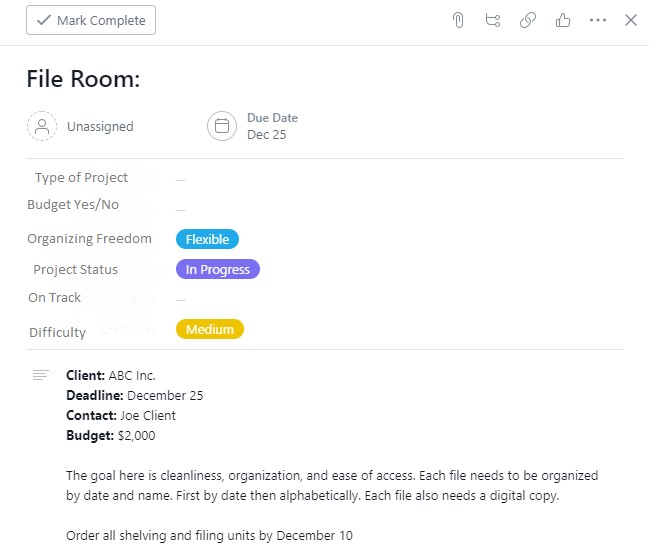How to Use Asana for Your Organizing Business
This page may contain links to Amazon.com or other sites from which I may receive commission on purchases you make after clicking on such links. Read my full Disclosure Policy

Before things are organized, they tend to be a mess. This is true whether you’re organizing an office, a closet, an entire home, or even digital files. Things are placed without rhyme or reason; organizers have to decide how things should be structured; and each task needs to be jotted down so things aren’t looked over. If others step into a project, it can be difficult to explain the plan over the chaos.
Everyone has their own way of organizing. However, there are a few things in common with each method in order to have success within a project and an organizing business as a whole. Each project needs its own goal and clearly outlined steps to reach that goal. A project needs tasks and subtasks to get to the end result. Delegating tasks and communicating progress with a team is important. And, finally, it’s helpful to discover which tactics work the best.
Thankfully, Asana is a project management software that can aid in all of these areas. Even organizers can use some help in keeping projects structured, and Asana is a great tool for an organizing business.
Keeping Projects Together
The great thing about this program is that the content of it can be whatever you need it to be. When you run an organizing business and you have multiple clients, projects, and projects within projects, it can be hard to keep them organized. Though many organizers are already utilizing some sort of online organizing app, utilizing a project management software like this can be an easy hack in organizing the operations of your business. Asana allows you to organize your clients, and within those clients you can list projects. Within those projects, you can have tasks lists. This allows you to easily keep your projects together as well as client information.
Asana is also incredibly user-friendly and easy to use. It’s free for a business with less than 15 people, and there are tiers of upgrade options. The platform also has an app that can be downloaded to your phone.

Creating Sections and Tasks
Organizers know how important a to-do list is to the process. Some of Asana’s many features that work well with an organizing business are the many checklist features. Within a project, you may have a list of sections, within those sections may be a series of tasks. You can even include subtasks within each task to make a project even more outlined. Each of those projects has their own area; the sections are listed; and the tasks and subtasks can be checked off. Each task and subtask is easily checked off and stored once the item is complete.
Each of these projects, sections, and tasks can have a set of customizable sections (depending on the version of Asana you have) so you can include how dire the situation is, deadlines, and other various labels. On top of all of that, every step through the project is timestamped. For many people, a good paper and pen is hard to turn away from. However, Asana is a great platform to share your task list, and you can still keep a physical planner for yourself.
Delegating Tasks
Another great attribute that Asana has is the ability to delegate tasks. Though many organizers may have trouble letting go in order to delegate tasks, it’s something that is important for the growth of your business and managing burnout. Each employee can have their own project where they can house their own personal timelines, tasks, and calendar that they work out of. Employers can have access to this and see who is assigned to what task and when each employee is planning on completing this task. At its core, Asana is a collaborative place to manage your projects. Task delegation is a major component, and this program makes that area of work easier.
Each task also has ample area to include information for the person you’re delegating tasks to. In the description, you can include all the information necessary for that person to complete the task. That person will also have access to many other areas of the overall project to get the bigger picture of the project’s goals.

Team Communication
Though Asana is an organizational tool, it’s one of the best tools in terms of team communication and collaboration as well. The fact that this program tracks progress in a project does a lot for the ability to relay what you’ve done to other employees and people within it. Without this tool, an employee may walk into a closet that needs organized without any notion of what was done or what is left to do. In Asana, they can see all of that. Teams can communicate directly in the program within certain tasks and sections that are in question. You can tag people, upload documents, and merge tasks.
Not only that, but Asana is great for keeping track of business outside of each project. This means meetings, discussions, and evaluations as well. It’s a one-stop tool for team collaboration in many different ways.
Making a Note of Trends
Many businesses use business analytics and business intelligence to decipher trends, results, performance, and issues within their business model. In an organizing business, it can be difficult to make many of these connections. Especially as a small business without access to big data tools, it may seem like many of these analytics don’t make sense for you. However, Asana’s ability to keep track of everything in each project can make it possible for you to watch some of the trends within your business with each client, project, and employee.
You may be able to predict how long certain projects will take, who has an easier time with certain tasks, and how often a client will need your services. With so many variables, it can seem like these trends are too hard to track, but Asana does offer plenty of data to make some trend connections and predictions.
Each organizing business runs a little differently. Some work on larger scales — some much smaller. Some run with one person, while some have many. Either way, Asana is a tool that can work for any type of organizing business model. When the job is organizing, it’s important to have your own tasks and projects outlined. Asana is one tool that can aid in that effort to help make you and your organizing business as successful as possible.




I’ve heard great things about Asana. I think of larger organizers use this to keep things on track. It really is great to be able to access the information from multiple locations. Everyone can check in and update projects no matter where they are. Thanks for sharing this!
I know that a lot of web designers, virtual assistant, and other online professionals use it, but this is the first time I’ve heard of using it for a personal service business. It sounds pretty cool!
This app sounds interesting. I like that you can delegate tasks to others. This would be useful for managing virtual staff in a small business. I plan on checking it out for my small business clients and myself.
That’s mainly how I’ve heard it used. It’s very popular for that!
I’ve heard of Asana but didn’t know that much about it. Thank you for sharing your detailed knowledge of the platform and uses. It’s funny how we get accustomed to doing things a certain way. I appreciate hearing about other options that could be useful and while I don’t see an immediate need for Asana, it’s good about its benefits.
I agree, it’s good to know what’s out there, even if it’s not something we need at the present ourselves.
I’ve heard a lot about Asana and have to look further into it. It might be just want I’m looking for.
Thanks.
Excellent! I hope it is!